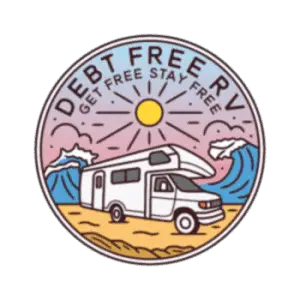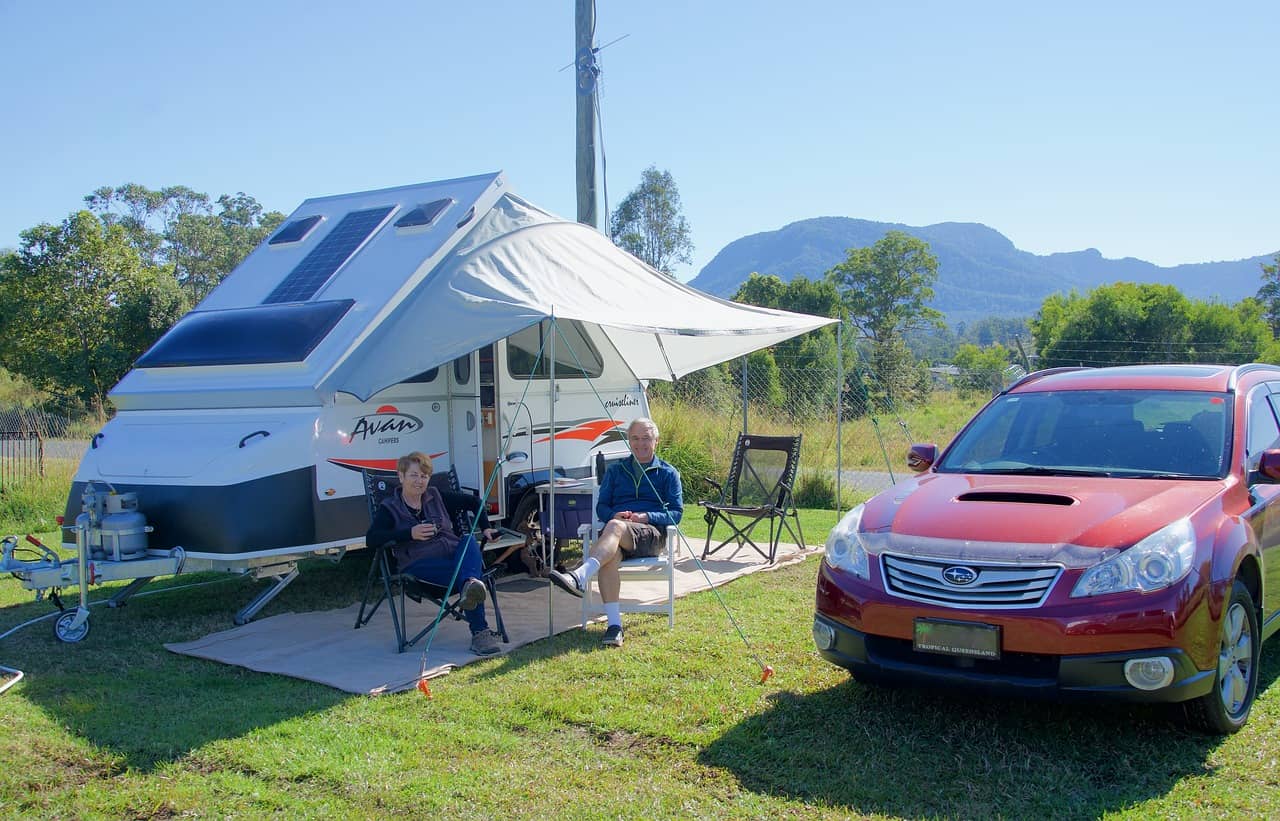RV awnings are an excellent investment, providing shade and increased functionality of your RV. But before buying and installing an awning, it’s important to understand the features of the different types available.
Depending on your preference and RV lifestyle, there are many different awnings to choose from, including: Manual, automatic, or fixed. Keep reading to find out which type of awning is right for you!
What are the Benefits of Buying an RV Awning?
An RV awning increases your RV’s usefulness and versatility, allowing you to use it for multiple purposes. Here are some reasons why you should buy and install an RV awning.
➢ It provides shade in the hot summer days. When the weather is too hot, spending time inside the RV can be extremely uncomfortable, but sitting out in the direct sunlight might not be the best alternative. The awning provides some shade, so you can read, relax, or prepare a BBQ dinner without being too hot.
➢ Even if you’re fond of the sun, spending too much in the sun without protection will leave your skin subject to the harmful ultraviolet rays. Ultraviolet rays can cause skin damage and also increase the risk of skin cancer.
➢ If you’re spending time inside your RV, the awning can also protect you from the annoying sun rays when you’re trying to relax or sleep. Moreover, the sun can cause the fading of your carpets and furniture, so the awning will provide the needed shade.
➢ An awning can also keep the rain away from the interior of your RV. The rain will slide away from your windows, so you can spend some peaceful time inside, without having everything getting wet or having to lock your windows.
➢ With some modifications, the awning can add an extra outdoor room. If it has walls, this outdoor sun room will be bug-free, so you can chill outside without having to deal with nasty mosquito bites.
RV Awning Types

Every accessory added to your RV can make your outdoor experience more comfortable, especially something like an awning which increases your ability to utilize more outside space. Here are the various types of RV awnings available:
Fixed
This awning will work for you if you’re not planning to move your RV around. It’s sturdy and practical, so it will protect you from the sun and rain when you’re chilling next to your RV. These awnings are designed to withstand the elements because they are permanent.
However, this is the least flexible option because you can’t adjust the awning. Moreover, it might fall out when you’re driving your RV.
Slide Out (Retractable Awning)
These awnings can be slid out when you want some shade. Retractable awnings are perfect for campers and beachgoers, so you can alternate between sun and shade according to your needs.
If you’re using your RV in the rain, you need to roll out the awning and let it dry to prevent mold growth. These awnings are manual, so you can easily adjust the shade depending on your needs. They are made of canvas, metal, acrylic, or vinyl, and they tend to be quite affordable.
Automatic
Automatic awnings are designed to overcome the shortcomings of the other models. They’re adjustable, easy to maintain, and easy to use. Using a simple button, you can fold or unfold the awning when needed. This will also protect the awning when you’re driving your RV.
However, these automatic awnings are the most expensive ones. They’re pretty tricky to install, and you will probably have to hire a professional to do the job. Moreover, if the awning gets damaged, repairs can be quite expensive.
Different Awning Materials
In addition to the models, there are several types of materials available. Each one of them comes with some pros and cons. Understanding the features of each material will help you decide on the most suitable one for your RV.
Acrylic Awnings
These are the most popular types of RV awnings. Acrylic awnings are made of synthetic materials that are highly resistant to weather conditions. They’re more durable than natural cotton blends and are incredibly versatile.
Pros
- Reasonably priced
- Provides good air circulation and breathability in hot weather
- Resistant to bugs
- Can handle sun, rain, snow, ice, dirt, and dust
- In wet weather, they repel most of the water and dry quickly, keeping the awning in good condition
Cons
- With time, the fabric stretches, and the awning starts to move in the wind. This affects its ability to provide shade and protection, and can also cause an annoying sound that deprives you of sleep when the wind hit the awning.
Vinyl Awnings
Just like acrylic awnings, these ones are made of an affordable synthetic fabric that handles different weather conditions.
Pros
- Vinyl is fade, scratch, and puncture-resistant
- Can slow down the spread of fire
- These awnings are waterproof
- The fabric stays taut on the frame
- Highly resistant to pollution, grime, bugs, and sun rays, and provide better protection than the acrylic awnings
Cons
- The water pools on top of the vinyl awning, so it can increase the risk of mold and mildew growth
- Vinyl attracts dust and requires regular cleaning
Metal Awnings
If you’re planning to keep your RV parked for a long time, you might need to think about something more durable. Metal awnings are usually made of aluminum, which is usually used in fixed awnings.
Pros
- They’re highly durable
- Resistant to extreme weather conditions
- Looks more elegant than fabric awning
- More expensive than other materials
- 100% waterproof
Cons
- They’re more expensive than other materials
- The sound of rain and hail falling on a metal awning can deprive you of sleep
- They require a lot of maintenance to prevent rust and corrosion
- Metals attract heat and will be extremely uncomfortable in hot weather
Wood
If you’re looking for an environmentally-friendly option, then you need to think about installing a wood awning.
Pros
- Less expensive than metal
- You can make your own awning if you have the right tools
Cons
- Not Waterproof
- Can easily get damaged
- Needs to be replaced more often

How to Maintain your RV Awning
RV awnings needs to be well maintained; otherwise, you will end up replacing it sooner than you should have. Here are some tips to help you take care of your awning.
➢ If you have an acrylic or vinyl awning, use water to hose it off. Check the awning to see if there are still any dirty spots. You can use a mild detergent that has been specifically designed for this process, as this will protect the waterproof coating and keeps the fabric in excellent condition
Too much scrubbing can damage the fabric. You can reinstall a waterproof coating to keep the RV awning in excellent condition. The frequency of cleaning depends on the weather condition and where you park and drive your RV
➢ Aluminum awnings don’t rust, but you can add a finish to remove oxidation and salt damage if you want the metal to maintain its color
➢ Check the construction of your fixed awning. If the metal parts look rusty, have them replaced
➢ If you install a fixed awning, try to keep one corner lower than the other. This won’t affect the benefits the awning will provide but will prevent the water from pooling on top of it
The water’s weight can put too much strain on the structure and can damage the awning permanently. When the water slides off, this will prevent the growth of mold and mildew, keeping your awning in perfect condition for the longest time possible
➢ Retractable awnings should be left to dry out completely before rolling them up. Rolling the fabric while it’s still wet will cause the growth of mold and will damage it forever
Moreover, it can cause a bad odor that you can smell when you’re inside your RV. Use a mold remover if you see any stains on your RV awning
➢ Don’t overexpose your RV awning to UV rays. Although the awning’s job is to protect you from the sun rays, you shouldn’t leave it extended if you’re not using it
UV rays can damage the acrylic and vinyl fabric, and you will eventually have to replace your awning too soon. Even when it’s rolled up, you can use a PVC or aluminum cover to protect the fabric from damage
➢ Invest in a stabilizer kit. This will work if you’re extending your RV awning in windy conditions. It protects the construction and guarantees that the awning will last for a long time. You can also de-flapper clips to keep the awning stable in rain and wind
Wrap Up
Installing an awning is an excellent addition to your RV, as they provide shade and additional usable, comfortable, outdoor space!
There are several designs that work for various purposes, and you can also choose between different materials.
Like with everything in your RV, make sure to keep your awning clean, and continue to inspect the awning, to ensure it maintains its good condition.
As always, Happy Travels!



